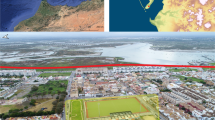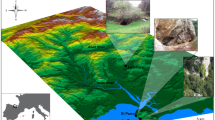Abstract
To evaluate coastal settlement and land use strategies among maritime hunter-gatherers, we analyzed oxygen isotope (δ18O) data from 131 marine carbonate samples from 21 California mussel (Mytilus californianus) shells obtained from a large ∼8,200-year-old shell midden (CA-SRI-666) on California’s Santa Rosa Island. Seasonal distributions of the isotopic data were assigned using a paleo-sea surface temperature model created by comparing modern sea surface temperatures (SST) to a fully profiled ∼8,200-year-old shell. For 20 additional shells, we used two sampling strategies to compare season-of-harvest inferences and explore whether the Early Holocene site occupants were sedentary. Estimated season-of-harvest differed by 35 % between the two sampling methods, corroborating recent isotope analysis of an 8,800-year-old shell midden on San Miguel Island. Shellfish appear to have been collected year-round at CA-SRI-666 from intertidal or subtidal water temperatures similar to modern SST in the vicinity of eastern Santa Rosa Island. The isotope results are consistent with other evidence from CA-SRI-666 that suggest that the site served as a residential base for relatively sedentary maritime people.





Similar content being viewed by others
References
Andrus CFT (2011) Shell midden sclerochronology. Quat Sci Rev 30(21):2892–2905
Andrus CFT (2012) Mollusks as oxygen-isotope season-of-capture proxies in southeastern United States archaeology. In: Reitz E, Quitmyer I, Thomas D (eds) Seasonality and human mobility along the Georgia Bight. Scientific Publications of the American Museum of Natural History, New York, pp 123–132
Bailey G, Barrett J, Craig O, Milner N (2008) Historical ecology of the North Sea Basin: an archaeological perspective and some problems of methodology. In: Rick T, Erlandson J (eds) Human impacts on ancient marine ecosystems: a global perspective. University of California Press, Berkeley, California, pp 215–242
Bailey G, Deith M, Shackleton N (1983) Oxygen isotope analysis and seasonality determinations: limits and potential of a new technique. Am Antiq 48(2):390–398
Balter M (2011) Do island sites suggest a coastal route to the Americas? Sci 331(6021):1122
Bayne BL (1976) Marine mussels, their ecology and physiology. Cambridge University Press, Cambridge
Coe W, Fox DL (1942) Biology of the California sea-mussel (Mytilus californianus). I. Influence of temperature, food supply, sex, and age on the rate of growth. J Exp Zool 90(1):1–30
Coe W, Fox DL (1944) Biology of the California sea-mussel (Mytilus californianus). III. Environmental conditions and rate of growth. Biol Bull 87:59–72
Culleton BJ, Kennett DJ, Ingram B, Erlandson J (2006) Intrashell radiocarbon variability in marine mollusks. Radiocarb 48(3):387–400
Culleton BJ, Kennett DJ, Jones T (2009) Oxygen isotope seasonality in a temperate estuarine shell midden: a case study from CA-ALA-17 on the San Francisco Bay, California. J Archaeol Sci 36(7):1354–1363
Eerkens J, Rosenthal J, Stevens NE, Cannon A, Brown EL, Spero HJ (2010) Stable isotope provenance analysis of Olivella shell beads from the Los Angeles Basin and San Nicolas Island. J Isl Coast Archaeol 5:105–119
Epstein S, Buchsbaun R, Lowenstam H, Urey H (1951) Carbonate-water isotopic temperature scale. Bull of the Geol Soc Am 62:417–426
Epstein S, Buchsbaun R, Lowenstam H, Urey H (1953) Revised carbonate–water isotopic temperature scale. Bull Geol Soc Am 64:1315–1326
Erlandson JM (1994) Early hunter-gatherers of the California Coast. Plenum Press, New York
Erlandson JM, Braje TJ, Rick TC (2008a) Tuqan chert: a “mainland” Monterey chert source on San Miguel Island, California. Pac Coast Archaeol Soc Q 40(1):22–34
Erlandson JM, Moss M, Des Lauriers M (2008b) Life on the edge: early maritime cultures of the Pacific Coast of North America. Quat Sci Rev 27:2232–2245
Erlandson JM, Rick TC, Jew NP (2012) Wima chert: 12,000 years of lithic resource use on Santa Rosa Island. J Calif Gt Basin Anth 32:76–85
Erlandson JM, Rick TC, Braje TJ, Casperson M, Culleton B, Fulfrost B, Garcia T, Guthrie DA, Jew N, Kennett D, Moss ML, Reeder L, Skinner C, Watts J, Willis L (2011) Paleoindian seafaring, maritime technologies, and coastal foraging on California’s Northern Channel Islands. Sci (331)6021: 1181–1185
Fitzhugh B, Kennett D (2010) Seafaring intensity and island–mainland interaction along the Pacific Coast of North America. In: Anderson A, Barrett J, Boyle K (eds) The global origins and development of seafaring. McDonald Institute for Archaeological Research, University of Cambridge, Cambridge, pp 69–80
Ford HL, Schellenberg SA, Becker BJ, Deutschman DL, Dyck KA, Koch PL (2010) Evaluating the skeletal chemistry of Mytilus californianus as a temperature proxy: effects of microenvironment and ontogeny. Paleoceanography 25, PA1203. doi:10.1029/2008PA001677
Fox D, Coe W (1943) Biology of the California sea-mussel (Mytilus californianus). II. Nutrition, metabolism, growth and calcium deposition. J Exp Zool 93:205–249
Glassow MA, Kennett DJ, Kennett JP, Wilcoxon LR (1994) Confirmation of Middle Holocene ocean cooling inferred from stable isotopic analysis of prehistoric shells from Santa Cruz Island, California. In: Halvorson W, Maender G (eds) the fourth California islands symposium: update on the status of resources. Santa Barbara Museum of Natural History, Santa Barbara, California, pp. 223–232
Glassow MA, Thaker HB, Kennett DJ (2012) Red abalone collecting and marine water temperature during the Middle Holocene occupation of Santa Cruz Island, California. J Archaeol Sci 39:2574–2582
Gusick AE (2012) Behavioral adaptations and mobility of Early Holocene hunter-gatherers, Santa Cruz Island, California. Dissertation, University of California, Santa Barbara, California
Jew NP, Erlandson JM, Watts J, White F (2013) Shellfish, seasonality, and stable isotope sampling: δ180 analysis of mussel shells from an 8800 year old shell midden on California’s Channel Islands. J Isl Coast Archaeol 8:170–189
Johnson JR, Stafford Jr. TW, Ajie HO, Morris, DP (2002) Arlington Springs revisited. In: Browne D, Mitchell K, Chaney H (eds) Proceedings of the fifth California islands symposium, Santa Barbara Museum of Natural History, Santa Barbara, California, pp. 541–545
Jones T, Kennett D, Kennett J, Codding B (2008) Seasonal stability in Late Holocene shellfish harvesting on the central California Coast. J Archaeol Sci 35:2286–2294
Kennett DJ (1998) Behavioral ecology and the evolution of hunter-gatherer societies on the Northern Channel Islands, California. Dissertation, University of California, Santa Barbara, California
Kennett DJ (2005) The Island Chumash: behavioral ecology of a maritime society. University of California Press, Berkeley
Kennett DJ, Kennett JP (2000) Competitive and cooperative responses to climatic instability in coastal southern California. Am Antq 65:379–395
Kennett DJ, Kennett JP, Erlandson JM, Cannariato KG (2007) Human responses of Middle Holocene climate change on California’s Northern Channel Islands. Quat Sci Rev 26(3–4):351–367
Kennett DJ, Voorhies B (1996) Oxygen isotopic analysis of archaeological shells to detect seasonal use of wetlands on the southern Pacific coast of Mexico. J Archaeol Sci 23:689–704
Killingley JS (1981) Seasonality of mollusk collecting determined from O-18 profiles of shells. Am Antiq 46(1):152–158
Killingley JS, Berger WH (1979) Stable isotopes in a mollusk shell: detection of upwelling events. Sci 205:186–188
Kinlan BP, Graham MH, Erlandson JM (2005) Late Quaternary changes in the size and shape of the California Channel Islands: implications for marine subsidies to terrestrial communities. In: Garcelon D, Schwemm C (eds) Proceedings of the sixth California islands symposium. National Park Service Technical Publication CHIS-05-01, Institute for Wildlife Studies, Arcata, California, pp. 131–142
LaGrande AN, Schmidt GA (2009) Sources of Holocene variability of oxygen isotopes in paleoclimate archives. Clim Past 5:441–455
Martinson DG, Pisias NG, Hays JD, Imbrie J, Moore TC, Shackleton NJ (1987) Ag dating and the orbital theory of the ice ages: development of a high-resolution 0 to 300,000-year chronostratigraphy. Quat Res 27:1–29
McCrea JM (1950) On the isotopic chemistry of carbonates and a paleotemperature scale. J Chem Phys 18:849–857
Muhs DR, Simmons KR, Schumann RR, Groves LT, Mitrovica JX, Laurel D (2012) Sea-level history during the last interglacial complex on San Nicolas Island, California: implications for glacial isostatic adjustment processes. Paleozoogeography and tectonics. Quat Sci Rev 37:1–25
Orr P (1962) Arlington Springs man. Sci 135(3499):219
Phillips NE (2005) Growth of filter-feeding benthic invertebrates from a region with variable upwelling intensity. Mar Ecol Prog Ser 259:79–89
Rick TC, Erlandson JM, Vellanoweth RL, Braje TJ (2005a) From Pleistocene mariners to complex hunter-gatherers: the archaeology of the California Channel Islands. J World Prehist 19:169–228
Rick TC, Kennett DJ, Erlandson JM (2005b) Early-Holocene land use and subsistence on eastern Santa Rosa Island, California. Curr Res Pleistocene 22:60–62
Rick TC, Erlandson JM, Jew NP, Reeder-Meyers LA (2013) Archaeological survey and the search for Paleocoastal peoples of Santa Rosa Island, California, USA. J Field Archaeol 38:321–328
Rick TC, Robinson J, Ferguson K (2006) Stable isotopes from marine shells, ancient environments, and human subsistence on Middle Holocene Santa Rosa Island, California, USA. J Isl Coast Archaeol 1(2):233–254
Robbins J (2011) Investigating Holocene climate change on the Northern Channel Islands and cretaceous mosasaur ecology using stable isotopes. Dissertation, Southern Methodist University, Texas
Robbins J, Rick T (2007) The analysis of stable isotopes from California coastal archaeological sites: implications for understanding human cultural developments and environmental change. Proc Soc Calif Archaeol 20:29–33
Seed R (1976) Ecology. In: Bayne BL (ed) Marine mussels: their ecology and physiology. Cambridge University Press, Cambridge, pp 277–316
Seed R, Suchanek TH (1992) Population and community ecology of Mytilus. In: Gosling E (ed) The mussel Mytilus: ecology, physiology, genetics, and culture. Elsevier Science Publishers, Amsterdam, pp 87–169
Shackleton NJ (1969) Marine molluska in archaeology. In: Brothwell D, Higgs ES (eds) Science in archaeology. Thames and Hudson, New York, pp 407–414
Shackleton NJ (1973) Oxygen isotope analysis as a means of determining season of occupation of prehistoric middens. Archaeom 15(1):133–141
Schmidt D (1999) A review of California mussel (Mytilus californianus) fisheries biology and fisheries programs. Canadian stock assessment secretariat research document: ISSN 1480–4883, 99/187. Ottawa, Canada
Shaw WN, Hassler T, Moran D (1988) Species profiles: life histories and environmental requirements of coastal fishes and invertebrates (Pacific southwest): California sea mussel and bay mussel. U.S. Fish and Wildlife service biological report 82(11.84). U.S. Army Corps of Engineers, TR EL-82-4
Stuiver M, Reimer PJ (1993) Extended 14C data base and revised CALIB 6.0 14C age calibration program. Radiocarb 35:215–230
Toro JE, Innes DJ, Thompson RJ (2004) Genetic variation among life-history stages in a Mytilus edulis–M. trossulus hybrid zone. Mar Biol 145:713–725
Wanamaker AD, Dreutz KJ, Wilson T, Borns HW, Introne DS (2008) Experimentally determined Mg/Ca and Sr/Ca ratios in juvenile bivalve calcite for Mytilus edulis: implications for paleotemperature reconstructions. Geo-Mar Lett. doi:10.1007/S00367-008-0112-8
Wanamaker AD, Krutz KJ, Borns HW, Introne DS, Feindel S (2007) Experimental determination of salinity, temperature, growth, and metabolic effects on shell isotope chemistry of Mytilus edulis collected from Maine and Greenland. Paleoceanography 22, PA2217. doi:10.1029/2006PA001352
Winterhalder B, Kennett D, Grote M, Bartruff J (2010) Ideal free settlement of California’s Northern Channel Islands. J Anth Archaeol 29(4):469–490
Yesner DR, Barton CM, Clark GA, Pearson GA (2004) Peopling of the Americas and continental colonization: a millennial perspective. In: Barton CM, Clark GA, Yesner DR, Pearson GA (eds) The settlement of the American continent: a multidisciplinary approach to human biogeography. University of Arizona Press, Tucson, pp 196–213
Acknowledgments
The research design for stable isotope analysis was conducted by the senior author, in consultation with Brendan Culleton, Douglas Kennett, and Jack Watts. Our research was supported by the National Science Foundation (#0917677 to Erlandson and Rick and #1212418 to Erlandson and Jew), Channel Islands National Park (ARPA Permit PWR-1979-09-CA-04), and our home institutions. We thank Frances White for help with our statistical analyses and the editor and reviewers of Archaeological and Anthropological Sciences for help with the review, revision, and production of this manuscript.
Author information
Authors and Affiliations
Corresponding author
Appendix
Appendix
Rights and permissions
About this article
Cite this article
Jew, N.P., Erlandson, J.M., Rick, T.C. et al. Oxygen isotope analysis of California mussel shells: seasonality and human sedentism at an 8,200-year-old shell midden on Santa Rosa Island, California. Archaeol Anthropol Sci 6, 293–303 (2014). https://doi.org/10.1007/s12520-013-0156-1
Received:
Accepted:
Published:
Issue Date:
DOI: https://doi.org/10.1007/s12520-013-0156-1




